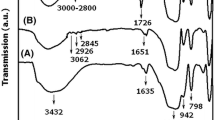Abstract
Transparent BaTiO3 nanoparticle/polymer hybrid was synthesized by polymerization and hydrolysis of barium titanium alkoxide modified with 2-vinyloxyethoxy ligand. Barium alkoxide, titanium alkoxide and 2-vinyloxyethanol were reacted affording a BaTiO3 precursor, which was then hydrolyzed and polymerized to form BaTiO3 particle/polymer hybrids below 100°C. BaTiO3 particles increased in crystallinity with increasing water amount for hydrolysis. The absorption edge of the hybrid film on silica plates shifted to shorter wavelength with decreasing crystallite size. Nano-sized BaTiO3 particle/polymer hybrid polymerized with methyl methacrylate (MMA) was shaped into a transparent and self-standing film with a refractive index of 1.595 at 589 nm.
Similar content being viewed by others
References
Alivisatos P.A. (1996). Semiconductor clusters, nanocrystals and quantum dots. Science 271:933
Beecroft L.L., Ober C.K. (1997). Nanocomposite materials for optical devices. Chem. Mater. 9:1302
Bradley D.C., Mehrotra R.C., Gaur D.P. (1978). Metal Alkoxide. Academic, New York, p. 118
Brandrup J., Immergut E.H. (1989). Polymer Handbook. 3rd. ed., John Wiley & Sons, New York, V-77
Campion J-F., Payne D.A., Chae H.K., Maurin J.K., Wilson S.R. (1991). Synthesis of bimetallic barium titanium alkoxides as precursors for electrical ceramics. Inorg. Chem. 30:3244
Charles S.W. & J. Popplewell, 1980. Ferromagnetic liquids, In: Wohlfarth E.P. ed. Ferromagnetic Materials, Vol. 2. North-Holland, Amsterdam, 509–559.
Cullity B.D. (1978). Elements of X-ray Diffraction. 2nd ed., Addison-Wesley, Reading, MA, p. 284
Davis G.M., Gower M.C., (1989). Epitaxial growth of thin films of BaTiO3 using excimer laser ablation. Appl. Phys. Lett. 55:112
Gomez-Romero C., Sanchez C., (2004). Functional Hybrid Materials. Wiley-VCH, Weinheim, p. 4
Guo W., Datye A.K., Ward T.L. (2005). Synthesis of barium titanate powders by aerosol pyrolysis of a Pechini-type precursor solution. J. Mater. Chem. 15:470
Hirano S., Yogo T., Sakamoto W., Yamada S., Nakmaura T., Yamamoto T., Ukai H. (2001). In situ processing of electroceramic fine particles/polymer hybrid. J. Euro. Ceram. Soc. 21:1479
Hoyer P., Weller H. (1994). Size-dependent redox potentials of quantized zinc oxide measured with an optically transparent thin film electrode. Chem. Phys. Lett. 211:379
Jona F. & G. Shirane, 1993. Ferroelectric Crystals, Dover, Mineola, NY, p. 108.
Kyprianidou-Leodidou T., Caseri W., Suter U.W. (1994). Size variation of PbS particles in high-refractive-index nanocomposites. J. Phys. Chem. 98:8992
Last J.T. (1957). Infrared-absorption studies on barium titanate and related materials. Phys. Rev. 105:1470
Lu X.M., Zhu J.S., Zhang W.Y., Ma G.O., Wang Y.N. (1996). The energy gap of r.f.-sputtered BaTiO3 thin films with different grain size. Thin Solid Films 274:165
Mazdiyasni K.S., Dolloff R.T., Smith J.S. (1969). Preparation of high-purity submicron barium titanate powders. J. Am. Ceram. Soc. 52:523
Palik E.D. (1998). Handbook of Optical Constant of Solids II. Academic Press, San Diego, p. 789
Silverstein, R.M., F.X. Webster & D.J. Kiemle, 2005. Spectrometric Identification of Organic Compounds, 7th ed., John Wiley & Sons, New York, 72, 127.
Wemple S.H., DiDomenico M. Jr., Camlibel I. (1968). Dielectric and optical properties of melt-grown BaTiO3. J. Phys. Chem. Solids 29:1797
Wood R.W., 1961. Physical Optics, 3rd ed., Dover, New York, 425.
Woudenberg F.C.M., Sager W.F.C., ten Elshof J.E., Verweij H. (2005). Nanostructured barium titanate thin films from nanoparticles obtained by an emulsion precipitation method. Thin Solid Films 471:134
Yogo T., Yamada S., Kikuta K., Hirano S., (1994). Synthesis of barium titanate/polymer composites from metal alkoxide. J. Sol-Gel Sci.Tech. 2:175
Yogo T., Ukai H., Sakamoto W., Hirano S. (1999). Synthesis of PbTiO3/organic hybrid from metalorganic compounds. J. Mater. Res. 14:3275
Yogo T., Banno K., Sakamoto W., Hirano S., (2003). Synthesis of a KNbO3 particle/polymer hybrid from metalorganics. J. Mater. Res. 18:1679
Yogo T., Yamamoto T., Sakamoto W., Hirano S. (2004). In situ synthesis of nanocrystalline BaTiO3 particle-polymer hybrid. J. Mater. Res. 19:3290
Yuh J., Nino J.C., Sigmund W.M. (2005). Synthesis of barium titanate nanofibers via electrospinning. Mater. Lett. 59:3645
Author information
Authors and Affiliations
Corresponding author
Rights and permissions
About this article
Cite this article
Sumida, K., Hiramatsu, K., Sakamoto, W. et al. Synthesis of transparent BaTiO3 nanoparticle/polymer hybrid. J Nanopart Res 9, 225–232 (2007). https://doi.org/10.1007/s11051-006-9140-3
Received:
Accepted:
Published:
Issue Date:
DOI: https://doi.org/10.1007/s11051-006-9140-3




